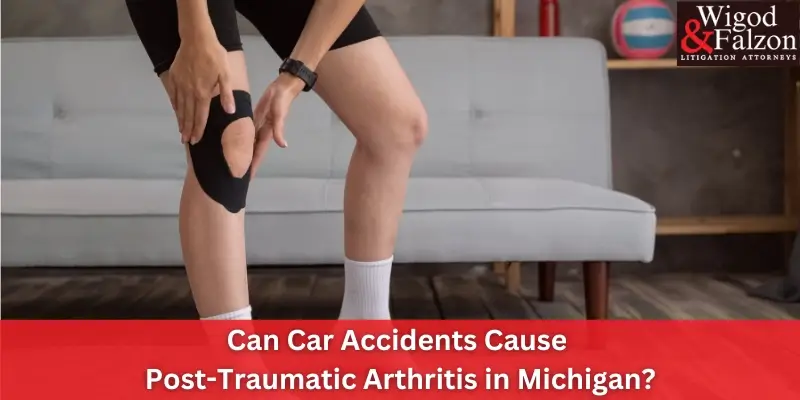|
|
Last Modified on Apr 18, 2025
Auto accidents can have devastating consequences beyond the acute injury associated with the actual traumatic event, like a fractured bone. One long-term health concern that often develops following vehicle collisions is arthritis. While we typically associate arthritis with aging, traumatic events like car accidents can either directly cause or significantly worsen arthritic conditions.
The Connection Between Auto Accidents and Arthritis
Arthritis is inflammation of one or more joints. This inflammation leads to pain, stiffness, and decreased range of motion. While there are over 100 types of arthritis, post-traumatic arthritis (PTA) is linked explicitly to physical trauma, such as that experienced in auto accidents.
When a vehicle collision occurs, the body absorbs tremendous forces. While safety features like seatbelt and airbags can reduce the severity of trauma suffered in an auto accident, one’s joints can also undergo injury. The sudden, violent movements during a crash can damage cartilage, ligaments, and other joint structures, setting the stage for arthritis development.
How Auto Accidents Directly Cause Post-Traumatic Arthritis
Post-traumatic arthritis occurs when the cartilage and bone within a joint are damaged, leading to irregular joint surfaces. This damage disrupts the smooth gliding motion of the joint, creating friction, inflammation, and pain. According to some research, approximately 12% of symptomatic osteoarthritis cases are post-traumatic in nature.
Several mechanisms explain how auto accidents lead to PTA:
Direct Joint Damage: The impact of a collision can cause micro fractures in the joint surface itself. Even after healing, these fractures often leave the joint surface irregular, accelerating cartilage wear.
Cartilage Damage: The extreme forces in a car accident can directly damage articular cartilage without fracturing bones. This damage might not be immediately apparent on imaging but progressively worsens.
Ligament and Tendon Injuries: Tears to ligaments and tendons around joints create instability. This instability allows for abnormal movement patterns, increasing stress on cartilage and accelerating degeneration.
Disruption of Joint Mechanics: Even after initial healing, altered biomechanics from accident injuries can place uneven stress on joint surfaces, expediting cartilage breakdown.
Commonly Affected Joints After Auto Accidents
While any joint can develop post-traumatic arthritis following an accident, certain areas are particularly vulnerable:
Knee Joints: The knee frequently impacts the dashboard during collisions, making it susceptible to PTA. A study in the Journal of Bone and Joint Surgery found that approximately 50% of people who suffer certain types of knee injuries in accidents develop arthritis within 10-20 years.
Wrist and Hand Joints: The natural reaction to brace against impact means hands and wrists often absorb significant force during accidents.
Spinal Joints: Whiplash and other spinal injuries can damage the facet joints between vertebrae, leading to cervical or lumbar arthritis.
Shoulder Joints: Shoulder injuries from seatbelts or side impacts can destabilize these
complex joints, setting the stage for arthritis.
Hip Joints: Though protected, severe accidents can cause hip fractures or dislocations that significantly increase arthritis risk.
How Auto Accidents Exacerbate Existing Arthritis
For individuals who already have arthritis, an auto accident can dramatically worsen their condition. Even minor accidents can aggravate arthritic joints through:
Increased Inflammation: Physical trauma triggers inflammatory responses that can heighten existing arthritis pain and accelerate joint deterioration.
Joint Destabilization: Accidents can damage already compromised supporting structures around arthritic joints.
Treatment Disruption: Injuries may require modifications to existing arthritis treatment regimens, potentially allowing disease progression.
Psychological Stress: The trauma of an accident raises stress hormone levels, which can increase inflammation and pain perception.
Signs That Arthritis May Be Developing After an Accident
Post-traumatic arthritis doesn’t always manifest immediately after an accident. Symptoms may develop gradually over months or even years. Warning signs include:
- Persistent joint pain that doesn’t resolve with initial injury healing
- Joint stiffness, particularly after periods of inactivity
- Swelling or warmth around the affected joint
- Reduced range of motion compared to before the accident
- Cracking or grinding sensations (crepitus) with joint movement
- Joint pain that worsens with activity or weather changes
If these symptoms develop following an auto accident, medical evaluation is crucial for early intervention.
Diagnosis and Documentation Challenges
A potential problem in diagnosing traumatic arthritis is the possibility of a delay in the onset of the condition. A clinical physician should refer back to the original medical documentation following the accident to determine if the arthritic changes are linked to the trauma. That is why the victims of the trauma should be detailed in their presentation of injury to the first responders and ER physicians. An experienced car accident lawyer can also help ensure that medical records and evidence are properly documented to support a future claim.
Diagnostic approaches typically include:
- Detailed medical history emphasizing the accident and subsequent symptoms
- Physical examination focusing on joint function and stability
- Imaging studies (X-rays, MRIs, CT scans) to assess joint damage
- Comparison with pre-accident medical records when available
Treatment and Management Strategies
Managing post-accident arthritis typically requires a multifaceted approach:
Pain Management: Both pharmacological (NSAIDs, analgesics) and non-pharmacological methods (heat/cold therapy, TENS units).
Physical Therapy: Structured exercise programs can improve joint stability and function without increasing inflammation.
Weight Management: Maintaining a healthy weight reduces stress on affected joints.
Assistive Devices: Braces, walking aids, or ergonomic adaptations may help manage pain.
Injections: Injections of various medications can provide temporary relief.
Surgical Interventions: In severe cases, procedures ranging from arthroscopy to total joint replacement may be necessary.
Legal and Insurance Considerations
The connection between auto accidents and arthritis has important implications for insurance claims and legal proceedings in Michigan. Since arthritis may develop months or even years after an accident, these cases can become complex. Choosing healthcare providers who understand the importance of thorough documentation is essential for establishing causation and building a strong claim.
Preventive Measures
While not all post-accident arthritis can be prevented, certain steps may reduce risk:
- Seeking medical attention after an accident, even of the “fender-bender variety,
- Following through with all recommended treatments for noted injuries;
- Completing prescribed rehabilitation programs;
- Making ergonomic modifications to reduce stress on injured joints;
- Maintaining overall joint health through appropriate exercise and nutrition.
Arthritis After a Car Accident Shouldn’t Be Overlooked
The relationship between auto accident trauma and arthritis represents an often overlooked aspect of crash-related health consequences. Understanding this connection is crucial for accident victims and healthcare providers. Through appropriate medical care, documentation, and management strategies, the impact of post-traumatic arthritis can be minimized, allowing accident survivors to maintain better long-term joint health and quality of life.
Contact Our Team to Discuss Your Case
If you’ve been involved in an auto accident, monitoring your joint health should be a priority in your recovery journey, even months or years after the initial trauma has healed. You can connect with our attorneys team at Wigod & Falzon to get the free consultation.





